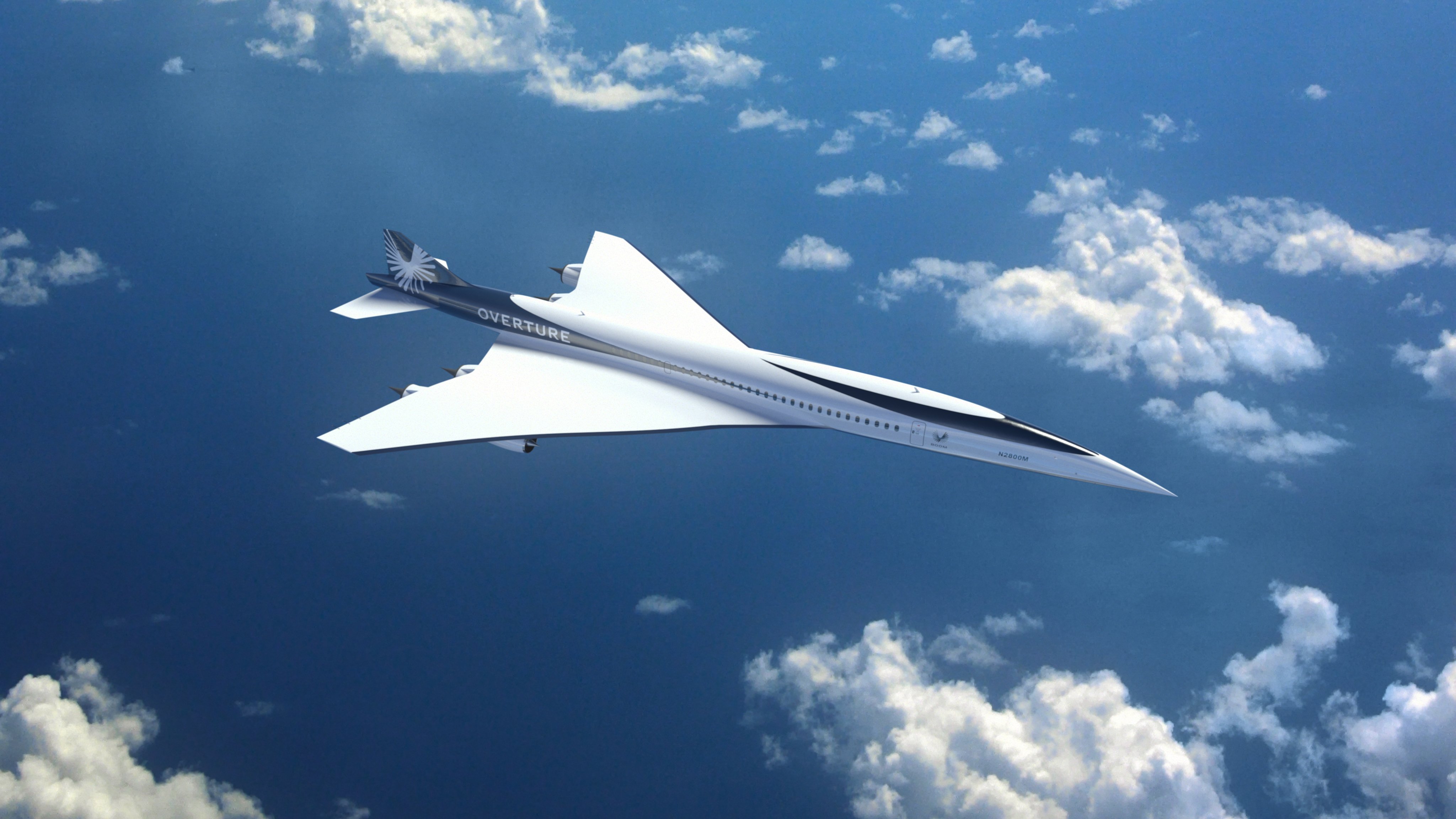Boom, the U.S. start-up working on ambitious plans to bring a supersonic airliner into commercial service by the end of this decade, says it will develop its own engine for the Overture program with a team of engine designers, an additive manufacturer, and a turbine engine maintenance specialist. On December 13, the company announced a trio of partners for the planned Symphony turbofan, including Florida Turbine Technologies, a unit of Kratos Defense & Security Solutions, which will design the engine; GE Additive providing additive technology design consulting; and StandardAero for engine maintenance.
The new engine will produce 35,000 pounds of takeoff thrust and features a twin-spool architecture with a single-stage fan and a passively cooled high-pressure turbine using traditional hot-section materials. The medium-bypass-ratio engine will not be equipped with an afterburner.
Boom is targeting the rollout of the Mach 1.7, four-engine Overture in 2024 at its Greensboro, North Carolina, factory followed by the first flight in 2027 and type certification in 2029. Certification of the Symphony engine will be under FAA and EASA Part 33 regulations.
Florida Turbine Technologies employs engineers with experience working on the design of the F-119 and F-135 turbine engines for the F-22 and F-35 supersonic military aircraft. The company has also developed and produced small turbine engines for cruise missiles and unmanned aerial systems.
The Symphony announcement comes after traditional aircraft engine manufacturers declined to participate in the Boom program. In mid-2020, Rolls-Royce and Boom agreed to explore technical requirements for Overture’s engine needs. In September, however, Rolls-Royce issued a statement that said, “We’ve completed our contract with Boom and delivered various engineering studies for their Overture supersonic program. After careful consideration, Rolls-Royce has determined that the commercial aviation supersonic market is not currently a priority for us and, therefore, will not pursue further work on the program at this time.”
According to Blake Scholl, founder and CEO of Boom Supersonic, “Developing a supersonic engine specifically for Overture offers by far the best value proposition for our customers. Through the Symphony program, we can provide our customers with an economically and environmentally sustainable supersonic airplane—a combination unattainable with the current constraints of derivative engines and industry norms.”
Boom claims that the “Overture’s new propulsion system will operate at net zero carbon and meet Chapter 14 noise levels.” Although the engine will be designed to run on 100 percent sustainable aviation fuel, which can provide up to an 80 percent reduction in lifecycle carbon emissions compared to jet-A, Boom has not explained how the Overture will be able to fly at net zero carbon emissions, although carbon offsets are a likely strategy.
A benefit of developing a new engine is that the “Symphony is expected to deliver a 25 percent increase in time on-wing and significantly lower engine maintenance costs, reducing overall airplane operating costs for airline customers by 10 percent,” according to Boom.
Can Boom Go It Alone?
To gain further insight into the risks that Boom Supersonic is taking by adding engine development to its program, FutureFlight spoke with Michael Riegel, founder of consultancy Aviation IQ. Riegel advised potential investors in the now-defunct Aerion supersonic business jet program and has many years of experience in the aerospace industry, including working for Bombardier, studying new aircraft programs, and advising investors about the risks involved in developing new aircraft.
Riegel explained that not only is it rare that an airframe manufacturer would develop the engine for a new aircraft, but the engine itself is unique, with a limited market. “Unless they plan to try and sell it to other supersonic manufacturers, it only has one application,” he said. Developing the engine and aircraft, he said, “adds risk in almost all areas, not just financial, although those are going to be considerable. Look at the multiple layers Boom is accumulating in terms of risk. I’m having a hard time imagining how anybody would be willing to pour billions into this.
“This begs all sorts of questions,” Riegel said. “Manufacturing turbine engines and turbine blades is an extremely difficult process, to put it mildly. If the engine partners have turned you down, I can’t imagine being suppliers for the very technical components you need. Adding the complexity of a new engine program takes a difficult project and turns it into something fanciful.”
From a financial perspective, bringing the aircraft to production is estimated to cost billions of dollars. Riegel said that “the last number I heard is $11 billion.” But that doesn’t include the cost of designing, testing, and manufacturing the engines. The risks the company is taking, he said, “extend well beyond the airframe and engine” and into the “need to develop an aircraft that can overcome regulatory hurdles” such as certification and how the transition to supersonic flight will be handled. Presumably, unless regulations change, supersonic passenger aircraft will be limited to breaking the sound barrier over oceans, thus limiting where they can fly efficiently. “The willingness of the regulators to lend a sympathetic ear is going to be challenging,” he said.
Riegel acknowledges that there is significant interest in the Boom program. “But starting from scratch without an engine puts it at square one. They have to determine if they can build an engine. There are so many questions rolling up, and I hope the existing investors are asking those questions and demanding answers.”
While Riegel isn’t working with any Boom investors, he said he has been asked to comment informally on the Overture program. “I have not accepted fees or been willing to advise anyone else, because I view this as a non-starter,” he said. “It’s laudable that somebody wants to rise to different challenges. It’s entirely possible I'll be proven wrong.”
FutureFlight asked Boom for further information regarding plans for engine manufacturing and net zero carbon emissions. “Today, we are focused on laying the groundwork for the Symphony propulsion program and will share more details soon,” a spokeswoman responded.
